Say you found yourself in possession of two 1947 Hudsons, a coupe and a convertible. The coupe was in much better shape, but you reeeeeally wanted to be able to drop the top—so you Frankensteined the two together to make one! Would you be willing to do that, or would that constitute the wanton destruction of a perfectly good Hudson coupe? The preservationist in me isn’t sure what he would do, but this is exactly what happened in the case of this ’47 Commodore. You can vote in the comments whether or not you’d do the same—or, if you’re in total agreement with the seller, vote with your wallet by heading here to eBay! With thanks to reader Fred H. for the find, let’s take a closer peep at this custom convertible.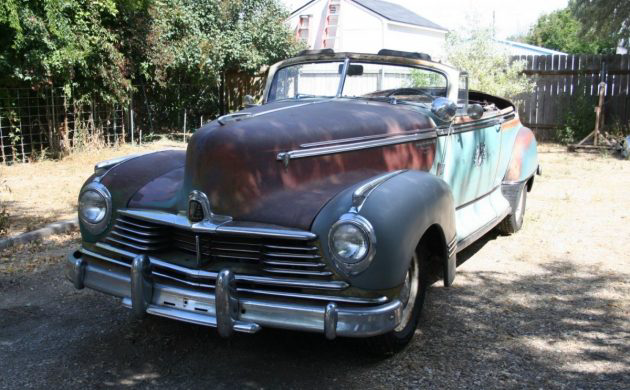
Legend has it that the seller had an eye on both coupe and convertible many years ago, but was only somewhat recently able to buy them. In doing so, it was discovered that the convertible, which had sat outdoors in Oregon for a long time, would be a much bigger project than the dry, Idaho-sourced coupe. Not to be deterred, this enterprising person used the convertible’s reinforced frame, plunked on the coupe’s body, whacked off its upper half, and butt-welded on the outer perimeter of the convertible’s roof opening.
That certainly makes the job sound simple enough, but the daylight visible in the trunk through the aforementioned roof opening suggests that some finishing work remains. The seller says that a stockpile of 1946-47 Hudson parts available to the buyer will include all the pieces need to complete the project, though.
That said, the seller also says that new front and rear wood bows are needed to complete the top, and it’s unclear whether those are included in the extra parts. I might also delicately question what the seller’s definition of “complete” is; while none of the more controversial buzzwords (“patina,” “rat rod”) are dropped, it’s unclear whether this project was intended to progress further visually, or if this is where it was meant to end up. That’s all a matter of taste, of course; a clue to the seller’s taste might be found in the description of both interior and exterior colors as “Nature.”
Another word not used is “restomod,” but if you were already on the “sacrilege” side of the fence, you might want to look away here: the Hudson’s original 255-cubic inch straight eight has been jettisoned in favor of a 1956 Chrysler 354 Firepower Hemi V8. This provides an extra 152 horsepower and 187 pound-feet of torque compared to the original mill, and looks pretty neat under the Hudson’s forward-hinged hood, too. A GM 700R4 Hydramatic four-speed handles shifting duties; otherwise everything else underneath is said to be original Hudson.
What do we think of this mutt of a Chrysler-powered Hudson coupe-cum-convertible? And if your vote is “buy,” would you leave it as-is—the seller says it’s a “fun car to drive around, gets a lot of attention”—finish it up like an original ’47 Commodore Convertible Brougham, or do something totally custom? Let us know in the comments!
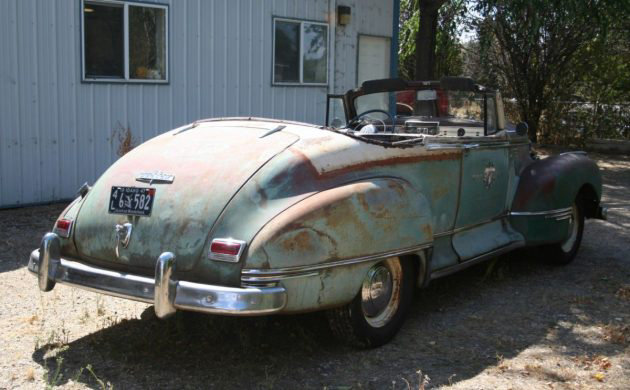
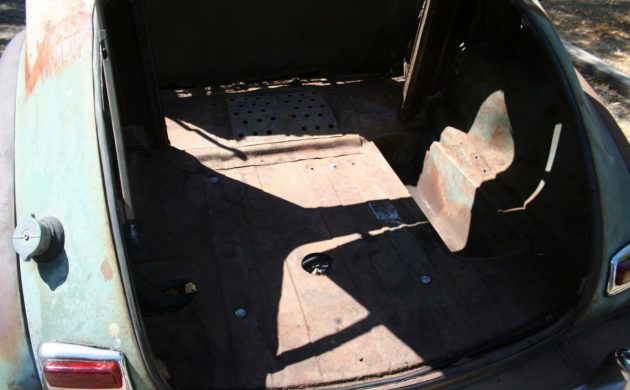

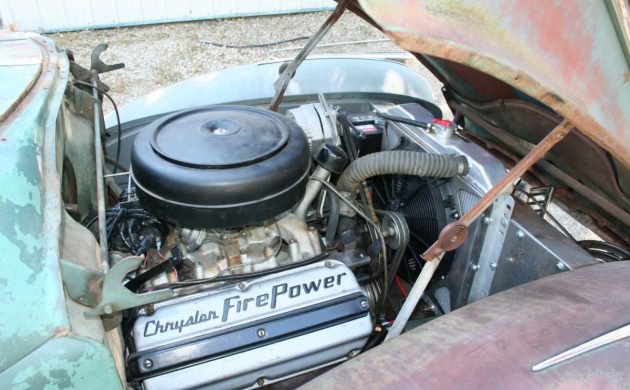
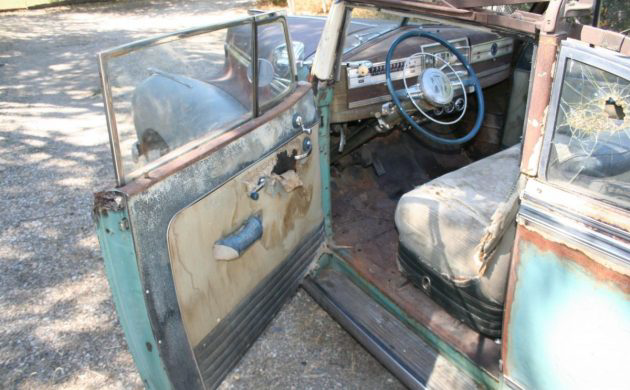
I’d pass. way too far removed from what Hudson built in `47. I would’ve consulted with Hudson enthusiasts of these models as to the best way to restore the original cvt. All this is, is resto-mod material, really. Good luck to whoever buys it; they’ll need DEEP pockets for this one.
Thought the paint “scheme” looked familiar
Ahhh yessss. The ol’ Hudson “Commode.” Us poor school teacher’s kids drove what ever had wheels. The “Commode” sedan belonging to my buddy’s great aunt, survived many road excursions in the state parks surrounding our little town. Thus inventing gravel drifting. Today’s squids should try THAT on yesterday’s tube-type tires.
Butt-welding panels are an art that I could never master. I can get by flange welding, but it takes me forever. Not too much warping, however, the grand kids are much better at it.
The CFP under the long nose is a personal favorite. As Don Garlits proved, you can fit a Hemi in a tight spot. Nicely executed on this intallation. Would like to see this one finished.
LOL! most people strive like hell to make their cars look new. Looks like this dude (or dare I say….dudette) strove for the opposite.
Pretty much all of the following commentary is based on my life’s experience, we each bring that which colors our views.
I find this perfectly acceptable, even as a former Hudson “restorer”. I built my ’36 Ford roadster in much the same way, though not starting with as nice hardware. At one time I think I had parts from 28/9 different cars to make just the body/fenders/hood/etc. I called it my ’36 roadster……the hard way.
The added bonus for me is the early hemi, this is a hot rod, my wheelhouse. Which brings me to brief commentary on terminology. Nathan tossed out three terms that prod. Patina we all pretty much recognize as overused/abused for the sake, often, of ad hyperbole. Rat rod is a contemptuous nomenclature for those of us who’ve spent more hours than a sane person should working to create attractive (yes, subjective, who’s eye judges?) hot rod outcomes. For the most part that term has faded (thank you Lord) from use, except for people who aren’t active in the hot rod slice of the hobby. This one is more…….let’s say………….potentially volatile; restomod. I understand what those who use it mean, though to those of us who actually build cars that are sometimes labeled as such, it’s a red (or maybe pink) flag. Right or wrong, we judge people by the words they use. Restomod to me means the person watches too much of that “reality” TV car building stuff and doesn’t really understand from a first hand perspective. Using that term doesn’t mean you’re ignorant or a jerk, or whatever other pejorative you choose, it just means, to the avid hot rodder, “you’re not one of us”. That doesn’t mean you should stop admiring, or commenting. Some may consider that a validation of your sophistication……………probably right
Take a breath Bob .
I suppose the easiest thing to do would be to finish it off “roadster style” with no top and drive it only on nice days. Love the Hemi powerplant.
For me, it looks good. I don’t mind any modifications to a car, However..it has to look like it is completely factory stock. I see too many corny modifications that look super tacky, and unpleasant, walmart, J C Whitney type quality stuff that I enjoy shaking my at and saying what a shame.
Anyway….yes..This looks pretty good. IMHO anyway
Hi Bob I agree for the most part with what you have to say, I even gave you a thumbs up. Clearly you are an experienced hot roders . When I think of a restomod I see it as not a hotrod at all but a car restored to original except for a some modern touches in critical areas, brakes, steering, engine, and drive line. Most of these are not built for the perpous of hotRoding, withTamer engines more in keeping with daily travel coupled to overdrive automatics. So I see a distinct difference between a restomod and a hot rod, I know the term hotrod is a much older term and this new term restomod must infuriate guys in the hotrod clubs but it is valid for what’s being done today. As for the Hudson I’d have restored the coupe body and sold the convertable body on to someone else, purely personal taste don’t really care for Convertables.
That’s the beauty of nuance and discussion, clarifying snap comments/judgements. Restomod makes sense when you dissect it to “modified restoration”, it’s just that the context that has in recent years dominated it’s use has colored it some. Here’s a link to a car that could easily, and accurately be a “restomod” in the sense of “modified restoration”; https://www.ebay.com/itm/1930-Ford-Model-A/123347427011
I really, make that REALLY, dig on this car. To the casual observer it looks stock, though to the more experienced there are numerous modification clues. I would tend to call it hot rod because from my youth we would take the cleanest car we could afford and then give it more horsepower, better sound, better visual appeal via stance and the like, just what this car does. Potato, potahto…………
Won’t even get into hot rod vs street rod………too big of a historical context to build for this site at this time.
I’m with you on this Uncle Bob. I get aggravated watching the big auction shows when the commentator gives a fairly correct definition of a restomod, then misuses the term on cars that don’t fit his definition. I will spare everyone the rest of my rant about those walking encyclopedias of automotive misinformation.
Patagonia, potahto very true I guess it comes down to interpretation. Maybe we spend to much time creating catigories.
Hey, if you wanna make an omelette, ya gotta break a few eggs. Just make damn sure ya don’t burn the omelette ’cause the eggs are already broken.
Hudsons to me were nice underrated cars good competitor to DeSoto and such, Looks like it would make a NICE full size convertible to drive and show with a month of work and $2000.–for a competent owner!
I’d finish it as a convertible conversion. The hard part is done. I’ve done something similar. It’s easier than it seems. After picture.
Before picture.
That’s a nice-looking car, and you definitely won’t see yourself coming and going. Good job.
Thanks for the comment. If I had it to do over, It’d be a different color. That black is a bear to keep looking nice. Here’s an in-process shot.
That’s the best Monte I’ve ever seen! It’s executed perfectly.
Sorry folks! Just not my cup of tea here.
Too many structural issues to make this
one safe to drive. Any time you cut the
roof off a closed car you remove 80-90%
of the strength that would normally hold
this car together. Good luck to the fool
that parts with his money to buy this.
Hope he’s got a good divorce attorney
too!
Aren’t you just a little ray of sunshine! Since the basic platform is the same as a Chevelle, which came from the factory as a convertible, I don’t see why you are being so hateful without all the facts as to how this was done. Comments like your’s serve no useful purpose other than allowing to you to vent your spleen, and we see these sorts of comments all the time.. The world could use a little less ugliness.
JSB, I think Kenneth was referring to the Hudson, but he maybe didn’t notice it said the body was put on the convertible frame. and all the convertible pieces transferred to the coupe. There are many uneducated commentors on this site that have no clue about old cars. A convertible in those days was a converted coupe, the main structural component being the reinforced frame, ergo no structural issues.
? He’s talking about the feature car, not jw454’s Monte Carlo. BTW, that’s a gorgeous conversion, JW.
Nah. Don’t worry about the structural integrity. If it’s done right. From the factory, extra braces are put between the frame rails to straighten the body. In fact, I had a 69 Torino 4 Door and a 69 Torino convertible. The convertible was about 300 pounds heavier because of the extra steel bracing.
Did this guy give that Hudson extra bracing to straighten the body? That’s the big question.
The big differance is the Torino is a unibody and the Hudson is a body on frame there would be more to be concerned about in the case of the Torino or for that matter the Monte Carlo. Body on frame cars are very much like trucks. You don’t worry about a truck and yet the cab and box are 2 completely separate pieces. Even in my 51 dodge it is clear that the roof is spot welded on and offers nothing in the way of structure which was a common method of construction in the early days of hard tops and Convertables. So I see this Hudson as being fine especially since the build to the steps to move over all relevant parts including the frame.
Actually, a TON of the convertibles, (Hudson’s that is) are identical structurally to the hardtops. I’m pretty sure in ’47 Hudson started building them accordingly, as the convertible tops were installed at the dealership!
Since it’s gone this far, you may as well just finish it off as a convertible conversion. But if you take it to an experienced body tech, you’re likely to hear that you need to pretty much start over on that part of it. The mechanical work may be done to a higher standard, hard to say. When (if) it’s all done, it could be a nice period hot rod, though if I’m being honest I cringe at the thought of what he did here in destroying the rusty old convertible and cutting up a nice coupe to create a franken-car that ultimately may have less value than either one.
I love all the comments, even the ones from car snobs, I get a chuckle at chuckleheads. I like the car, I like most cars. I would finish the top, maybe put disc brakes on front, dual master cylinder, and have a hot rod. Or is that a restomod? Keep the patina to piss off the purists and all the hot rod and other car snob clique types.
JW454, love the MonteConvert!
The ‘40’s Hudson and Packard convertibles are my favorite cars. I admire someone doing this sort of work as I would just make a mess trying to butt weld.
Can’t see the logic in buying this though. Can get a good to great looking Hudson convertible for less than this one is going to cost to finish.
I like it. Seeems the Traditional Hotrodder (notice I didn’t say old school, heck I’m still wondering where this old school that everyone is talking about is) Methodology. Use what you have on hand. one good body one rusty one, put ’em together., probably had the Hemi laying around and that’s what he used. It’s already together . Another term I loathe is, “it is what it is”. Finish er up. Any way you want. And have a blast with it!! Should cook down the road real nice with that Hee-my Moter!
Good luck to the new owner!
No one has mentioned the word “Custom”. As long as the work that has been done is quality, you can still finish this off nicely. A custom in my mind has period details like the hemi swap and some thought and engineering put into it.
Tuck and Roll interior? Lowered a bit?
Nice CUSTOM paint… Not anything Barris or Gene wouldn’t have done. It’s embryonic right now but you’d have a Very original (one of a kind) car when you’re done! Go for it Man!!!
I have the time and probably the ambition, but I do not have the fundage. It would be nice to see the finished product, however.
I admire the work and time gone into converting this car to a convertible, who knows maybe it all fitted up nice and easy. Lets be honest you are not getting a car to do concourse with. I do like it and having seen an excellent example one time when we were over there near Detroit in a museum which once upon a time belonged to some famous film star I could see this one painted up and reupholstered looking sharp as a tack, the Hemi well yes I’d leave that in there although there may be more fuel efficient engines that could have been used you aren’t going to have this to do economy runs in. If I lived there I think you could turn that into a very cool cruiser which you could travel from coast to coast in. My personal opinion is they are as ugly in the front as anything but that is what makes it a cool ride. Yes I would own that and a nice paint job but still another $20,000 or so to spend on it to have it looking very smick.
Anyone considering this car should consider parts avalability. I had a ‘40 sedan. Was able to get every part I ever needed. Only thing I wanted that was tough was the one year only overdrive transmission. My understanding is that parts for ‘47’s are even more plentiful.
Easy decision, spend another $15,000 and buy the Black 300H. A lot less work on a car that will very nicely appreciate and was built the way highly trained engineers designed it.
Bludgeon the coupe.
Having had a ’47 Club Coupe with Twin H, DriveMaster and Overdrive. (I was told that that was a very rare combo.) I am sad to see the coupe destroyed. However I had never seen a convert. before. It appears that the modifier tried to do the deed in the best way possible. And his welding skills are better than mine.
I would get the top completed (that may take a ton of money) “cheaply” recover the the door cards and seats and then get a “reasonable” paint job. I would call it a “hot rod” as it goes faster than stock and it’s body has been modified. (Upgraded brakes and some suspension upgrades would also be in order.)
I like it!
Gentlemen, I meant no disrespect. The
responses I leave on this site are based
on experiances that I’ve had as a motor
head over my very long lifetime. In my
64 years on this planet, I have seen many
morons take perfectly good cars, cut the
rooves off, and then be forced to scrap
the rest when the body collapses in on
itself. I hope that you’ll overlook an old
man’s rants as I’m quite set in my ways
(Just ask my neice) and only slowly
beginning to realize that the hobby is
changing quickly and that there are
new tecniques that make a conversion
such as this a practical reality today.
JW454, you sir have one slick looking
Monte Carlo ragtop. And while black is
a sharp color, I liked the factory color
much better. Just think what a person
woild see when you blow their minds
when you drop the top on your restored
’72 Monte Carlo. Food for thought: have
to sketch this one out and post it here
with my neice’s help of course. Don’t
think any less of me if I sketch in an
M-22 4-speed into the interior shot when
I do it. Thanks for coming to my defense
folks, I really do appreciate it.
I agree with Bigorangetruck!
jw454 really cool “custom”!
My 1955 Chev convert had an “X” added to the box/ladder frame for additional stiffness. As time has progressed on passenger vehicles that use body on frame construction. The frames have become lighter duty relying more and more on body structure to keep the flexing down to a minimum. Most trucks have separate cab and beds because of the length and different loads that can be present. That way the chassis can flex. The longer the wheelbase, the more need to flex. ( or to have greater suspension travel ). A very dramatic example would be your typical box truck. (ISUZU, International, etc) the body is welded to the frame at the rear and the rest of the body is attached to the frame with “U” bolts. Between the frame and the body are in most cases 2X4 type lumber. This allows the frame to flex without body or frame damage. Medium and heavy duty truck specifications list the frame RBI (resistance to bending index) and will list a separate warranty on the frame over the basic vehicle warranty.
Now days with uni-body vehicles, even the windshield is considered structure. Which is why they are now glued in. There is also a spec. for keeping unbelted bodies from flying out of the windshield. Again windshield strength and integrity to the structure.
In a unibody car the rule is NO flex. “Chassis stiffness” is measured by hertz. (All things have a frequency. This was emphasized by experiments performed by Nikola Tesla. And reinforced by an episode done by Myth Busters for the younger crowd.) I kind of became an expert in NVH ( noise, vibration and harshness) with experiences starting with vibration issues on Aspen/ Volare cars and BMW 320I s back in the 70s. ( The Aspen/Volare cars were the equivalent of tin foil.) Anyway I digress. I was a service manager at a BMW, Oldsmobile, Volvo dealership. A customer was having an issue with vibrations on his new Aurora. I knew that it was tires, but the customer was being a large pain and was sure that the car had inherent issues. GM sent out a field engineer to test the car. He brought out a very interesting piece of equipment where you attached sensors to different places on the car. While driving it measured vibrations (hertz) to give you clues on body rigidity, suspension compliance and drivetrain harmonics. It was a really neat tool and we played with it all day. We would remove a wheel weight to see if it could locate the source of the vibration ( it could) and place 200 pounds of sand bags in the trunk to change chassis flex ) to see the difference in the readings. Most people in the industry will acknowledge the fact that wine of the reasons that BMWs ride and handle so well is their chassis stiffness is superior to most other cars. (At least in the pre 2000 years) Some of the things that we discovered in our testing/playing around was that 1. I was correct in my diagnosis of tire issues on the Aurora. 2. The Aurora was significantly stiffer than the BMW 5 series! For a big car, the Aurora was a very nice riding and handling car. It’s downfall was the Northstar engine design. Some pickup trucks have a vibration GM calls beaming. It is a vibration that occurs when road imperfections like tar strips or when there are pavement layed in sections that have a rhythmic composition. The truck will vibrate like a bad tire or u-joint, but will smooth out when driving over a bridge. The vibration is actually the frame of the truck vibrating. You can verify that this is the condition by adding 200-300 pounds of weight just behind the tailgate. It may not go way completely. But it will change drastically. Many drivers notice it more when they have changed the vehicle in some way that changes the frequency of the vehicle. (Different shocks, lift kit, heavier tires, etc.) Extended and crew cab GM trucks are prone to this as are long bed Ford trucks. Dodge trucks have such flexible chassis that they have other issues. ( Don’t remove your receiver hitch on a Dodge as it is actually a chassis reinforcement,)
If you get a chance to see the Myth Busters episode where they just about give up on Tesla’s earthquake demonstration when they get very excited to get it shut down in a hurry. Being a Nikola Tesla fan, I knew it was going to happen. But it was a complete surprise to them. All physical objects in life have a frequency.
Love the comments. I’m a member of the Hudson club (HET) and the builder of this car posted it on our web site. He also posted the complete, end to end construction of a hard top for this car. Absolutely amazing work.
Second, as a long time member of HET, I joined when many of the old timers had worked at Hudson. I was going to restore (?) a junk yard find, a ’46 Hudson convertible that was only salvageable from above the floor pan. It sat in water too long. I also had a ’46 coupe in nice condition. Talking to the old timers, I was told “How do you think Hudson built converts?” They shoved a uncomplete coupe body on a beefed up chassis into a different area and proceeded to cut it up, add the extra bracing to the body and the top mechanism. The door pillar is doubled, bracing runs all around the rear of the body, large braces inside the rear fender wells brace the body. Windshield is cut down.
I went ahead with the conversion as a fellow member of the club had a body shop and did all of the metal work. Turned out a beautiful trophy winning car. I have pictures to prove it.
I would like to see your finished photos, very cool ride mate you did a great job there and as you said Hudson used a cut down coupe.
How do I post photos here?
Mike Corless, do you remember Norris Smith(alias Smitty) from Illinois? To me he was Uncle Smitty!
Sorry, can’t say I remember Norris Smith. I was in the Hudson club in Michigan from the 70s to 1993 and New Mexico from 1993 until about 2001 when I sold my Hudson..
He was in the Hudson club from the early to mid 60s (Illinois) until his death in 2003 (Houghton Lake Michigan)